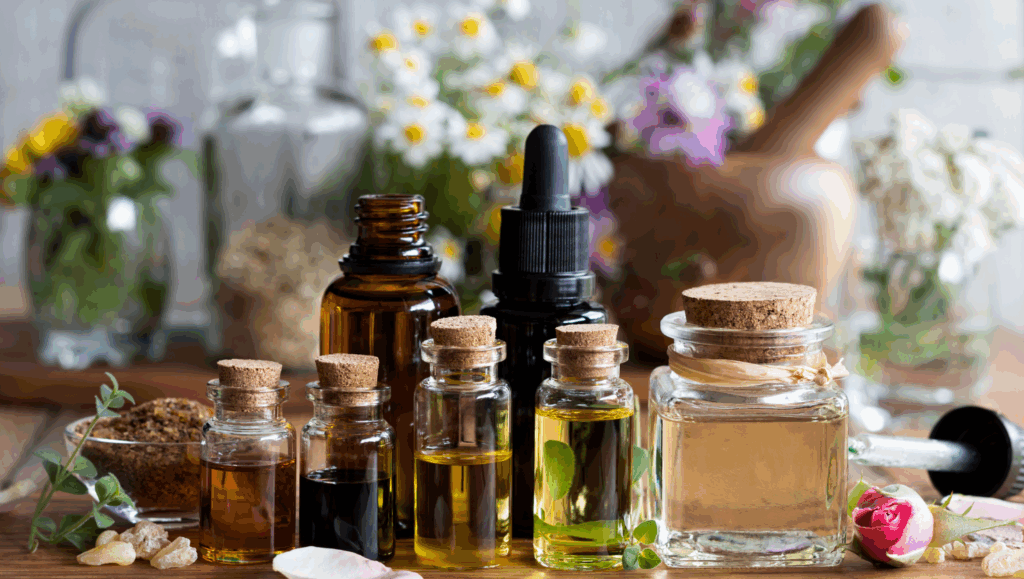Essential Oils

“Are you a lover of essential oils, just like I am?”
If the answer is yes, sit back and get ready to discover with me their benefits, precautions, extraction methods, and the reason why these products are so “powerful” in their use. Their intoxicating scent and the supposed “miraculous powers” have always fascinated me, and I want to take you with me into this fascinating world of essences, exploring how they can improve our physical and mental well-being.
Ready to take a journey into the world of essential oils? Let’s go!
WHAT ARE ESSENTIAL OILS?
(From now on, we’ll call them EOs)
Essential Oils (EOs), also known as volatile oils, are extracted from aromatic plant material rich in essence. Plants produce these essences for several reasons: to attract pollinators, to defend themselves from pathogens (like bacteria and fungi), and to serve as intermediaries in energy reactions.
EOs are therefore aromatic molecules that represent a very small fraction of the plant—but with a powerful impact.
“Wow, sounds interesting… let’s keep going!”
EOs are made up of volatile chemical compounds such as phenols, terpenes, and aldehydes, which make them highly flammable. These molecules are hydrophobic (they do not dissolve in water) and volatile, meaning they easily evaporate into the air. The amount of EO extracted from the plant is very low, generally between 0.01% and 2%, which explains why high-quality products tend to be expensive.
The most common extraction methods include:
-
Enfleurage (an expensive, traditional method)
-
Cold pressing (used mainly for citrus fruits)
-
Steam distillation (the most common technique)
The first two methods are the most delicate and preserve the molecular structure of the oils because they use low temperatures (below 35°C / 95°F). However, they are also more expensive than steam distillation.
FROM WHICH PARTS OF THE PLANT ARE ESSENTIAL OILS EXTRACTED?
Plants produce EOs in different parts, including:
-
Leaves (e.g., Sage and Lavender)
-
Flowers (e.g., Jasmine and Calendula)
-
Fruits (e.g., citrus fruits, extracted from the peel)
-
Roots (from aromatic plants that grow underground)
For plants with peels or rinds (like citrus fruits), cold pressing is the most common method, as it preserves the essence without altering its chemical composition.
TYPES OF ESSENTIAL OILS: ALLERGENIC AND PHOTOSENSITIZING
This article is packed with useful information, so to keep it concise, I’ll divide the topic into multiple sections.
In the next part, I will share a color-coded table with the main types of EOs, divided into ALLERGENIC and PHOTOSENSITIZING.
You’ll be able to download it and use it to make more informed choices about your favorite oils!
SAFETY PRECAUTIONS FOR ESSENTIAL OILS
Because EOs contain active chemical molecules like aldehydes, it’s essential to follow a few safety guidelines when using them.
For example, when preparing an aromatic massage oil, the percentage of EO must be very low (between 1% and 2%).
In practice, this means about 1 drop of essential oil for every 2 ml of carrier oil.
For larger preparations: 1 ml of EO per 100 ml of carrier oil.
If you want to combine multiple essences, remember that the total percentage of all essential oils combined must never exceed 1–2% of the total mixture.
Important: Never apply EOs directly to the skin undiluted—always use them diluted in a suitable carrier oil.
CONCLUSION
If you’ve made it this far, I bet you’re already thinking about which new essence to try next!
In the next article, I will guide you deeper into the world of essential oils, exploring the different types, their mind-body effects, and which ones to use with caution (including allergenic ones).
If you’re interested in this topic and want more information about essential oils, leave me a comment!
And if you want to purchase 100% pure, high-quality essential oils, [click here] or contact me if you can’t find the essence you’re looking for.
Wellnessaround is always by your side in your journey toward physical and mental well-being.
